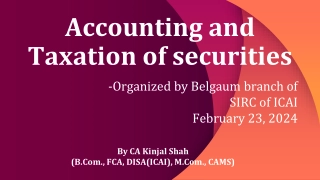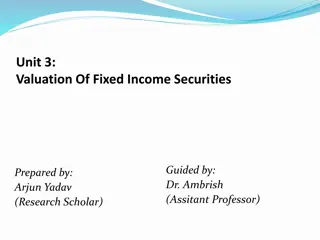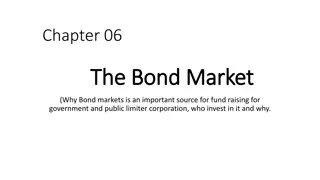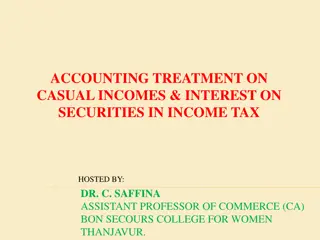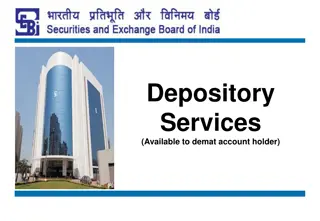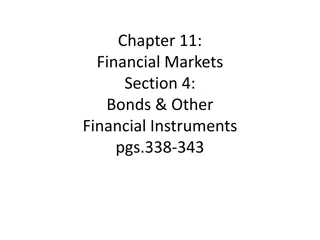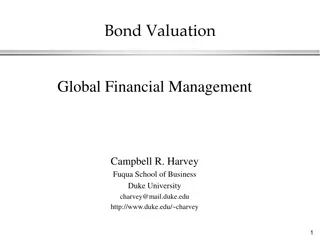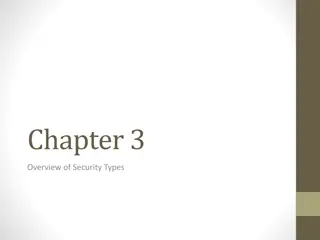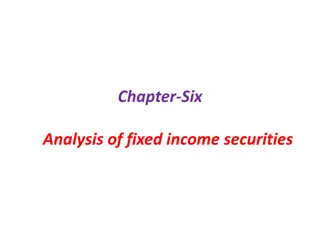Understanding Fixed Income Securities: Bonds Overview
Learn about fixed income securities in week 2 of the Fundamentals of Investment course, focusing on bond characteristics, types, and risks. Bonds are vital debt instruments issued by organizations to raise funds, with features like fixed maturity dates and interest rates. Explore various bond types such as fixed rate, floating rate, zero interest rate, inflation-linked, perpetual, and subordinated bonds.
Download Presentation

Please find below an Image/Link to download the presentation.
The content on the website is provided AS IS for your information and personal use only. It may not be sold, licensed, or shared on other websites without obtaining consent from the author. Download presentation by click this link. If you encounter any issues during the download, it is possible that the publisher has removed the file from their server.
E N D
Presentation Transcript
Course Name: Fundamentals of Investment Week 2: Fixed Income Securities
Week 2: Learning Objectives The basic objective is to understand the basics of fixed income securities. The aim is to share the concepts of Bond characteristics and types of Bonds. Default risk pertaining to fixed income securities will be discussed and credit rating agencies and their rating mechanism will also be shared with learners.
Meaning of bonds Bonds are issued by organizations generally for more than one year to raise money by borrowing. A bond is a fixed income instrument representing a loan made by an investor to a borrower (typically corporate or governmental). Bonds refer to high-security debt instruments that enable an entity to raise funds and fulfill capital requirements. It is a category of debt that borrowers avail from individual investors for a specified tenure.
Characteristics of a Bond/Essential features of Bonds A bond is generally a form of debt that the investors pay to the issuers for a defined time frame. In a layman s language, bond holders offer credit to the company issuing the bond. Bonds generally have a fixed maturity date. All bonds repay the principal amount after the maturity date; however, some bonds pay the interest and the principal to the bond holders. B.Com (H) VI Semester Fundamentals of Investment
Types of Bonds Fixed Rate Bonds In Fixed Rate Bonds, the interest remains fixed throughout the tenure of the bond. Owing to a constant interest rate, fixed rate bonds are resistant to changes and fluctuations in the market. Floating Rate Bonds Floating rate bonds have a fluctuating interest rate (coupons) as per the current market reference rate. B.Com (H) VI Semester Fundamentals of Investment
Types of Bonds Zero Interest Rate Bonds Zero Interest Rate Bonds do not pay any regular interest to the investors. In such types of bonds, issuers only pay the principal amount to the bond holders. Inflation Linked Bonds Bonds linked to inflation are called inflation linked bonds. The interest rate of Inflation linked bonds is generally lower than fixed rate bonds. Perpetual Bonds Bonds with no maturity dates are called perpetual bonds. Holders of perpetual bonds enjoy interest throughout. B.Com (H) VI Semester Fundamentals of Investment
Types of Bonds Subordinated Bonds Bonds that are given less priority than other bonds of the company in cases of a close down are called subordinated bonds. Subordinated bonds are given less importance in liquidation cases than senior bonds, which are paid first. Bearer Bonds Bearer Bonds do not carry the name of the bond holder, and anyone who possesses the bond certificate can claim the amount. If the bond certificate gets stolen or misplaced by the bond holder, anyone else with the paper can claim the bond amount. War Bonds Any government issues war Bonds to raise funds in cases of war. B.Com (H) VI Semester Fundamentals of Investment
Types of Bonds Serial Bonds Bonds maturing over a period of time in installments are called serial bonds. Climate Bonds Any government issues climate Bonds to raise funds when the country concerned faces any adverse changes in climatic conditions. Callable bonds Callable bonds are common in finance, but particularly in corporate bonds. The call option allows firms to be more flexible with their interest rates if they fall, and it also allows investors to earn a better return than if they held the bond until maturity. When market interest rates fall, firms can call their existing bonds and sell new bonds at a cheaper rate. In effect, in a period of falling interest rates, a callable bond may be less expensive to the issuer than a regular bond. B.Com (H) VI Semester Fundamentals of Investment
Default Risk It is also known as credit risk, refers to the possibility that a borrower will fail to meet their obligations in accordance with agreed terms. For lenders and investors, this means there s a risk that the borrower may not pay back a loan or meet interest payments, resulting in financial losses.
What is a Credit Rating? A credit rating is an assessment of the creditworthiness of a borrower in general terms or with respect to a particular debt or financial obligation. It can be assigned to any entity that seeks to borrow money an individual, corporation, state or provincial authority, or sovereign government. Evaluating the creditworthiness of an instrument comprises of both qualitative and quantitative assessments, making credit rating far from a straightforward mathematical calculation.
What are Credit Rating Agencies? A credit rating agency (CRA) is a company that rates debtors on the basis of their ability to pay back their interests and loan amount on time and the probability of them defaulting. CRAs were set up to provide independent evidence and research-based opinion on the ability and willingness of the issuer to meet debt service obligations, quintessentially attaching a probability of default to a specific instrument. Credit rating agencies in India came into existence in the second half of the 1980s. In India, CRAs are regulated by SEBI (Credit Rating Agencies) Regulations, 1999 of the Securities and Exchange Board of India Act, 1992.
SEBIs Detection for CRAs The Securities and Exchange Board of India tightened disclosure standards for credit rating agencies while assigning ratings to companies and their debt instruments. The regulator directed that rating agencies must now disclose the liquidity position of a company being rated. If the rating is assigned on the assumption of cash inflow, the agencies would need to disclose the source of the funding. Rating agencies must disclose their rating history and how the ratings have transitioned across categories. Credit rating firms will also have to analyze the deterioration of liquidity and also check for asset liability mismatch.
CRISIL This full-service rating agency is the major credit rating agency in India, with a market share of more than 60%. It is offering its services in financial, manufacturing, service, and SME sectors. The headquarter of CRISIL is in Mumbai The majority stake of CRISIL was held by the world s largest rating agency Standard & Poor s.
Credit Analysis and Research Limited Ratings (CARE) Ratings Credit Analysis and Research Limited Ratings was established in 1993. It is supported by Canara Bank, Unit Trust of India (UTI), Industrial Development Bank of India (IDBI), and other financial and lending institutions. This is considered as the second-largest credit rating company in India. The headquarter of Credit Analysis and Research Limited Ratings is in Mumbai
Small and Medium Enterprises Rating Agency (SMERA) It is a rating agency entirely created for the rating of Small Medium Enterprises. It is a joint enterprise by SIDBI, Dun & Bradstreet Information Services India Private Limited (D&B), and some chief banks in India. The headquarter of SMERA is in Mumbai It has accomplished 7000 ratings.
ONICRA Credit Rating Agency It was incorporated by Mr. Sonu Mirchandani in 1993 It investigates data and arranges for possible rating solutions for Small and Medium Enterprises and Individuals. The headquarter of ONICRA Credit Rating Agency is located in Gurgaon It has a broad experience in performing a wide range of areas such as Accounting, Finance, Back- end Management, Analytics, and Customer Relations. It has rated more than 2500 SMEs.
Fitch (India Ratings & Research) Fitch Ratings is a global rating agency dedicated to providing the world s credit markets with independent and prospective credit opinions, research, and data. The headquarter of Fitch Ratings is in Mumbai.
ICRA It was created in 1991 by prominent financial institutions and commercial banks in India with a devoted crew of experts for the MSME sector Moodys, which is considered as the International credit rating agency holds the major share.
Credit ratings play a crucial role in assessing the default risk of an investment. In general, a credit rating is an evaluation of the creditworthiness of a borrower, issuer, or security. Credit ratings are used by investors, banks, and other financial determine the likelihood of default institutions to
Learning Outcome Learners will learn about the time value of money concepts and basics of fixed income securities. Bond yield calculations will be learnt by them. Knowledge about default risk and credit rating agencies will also be gained.


